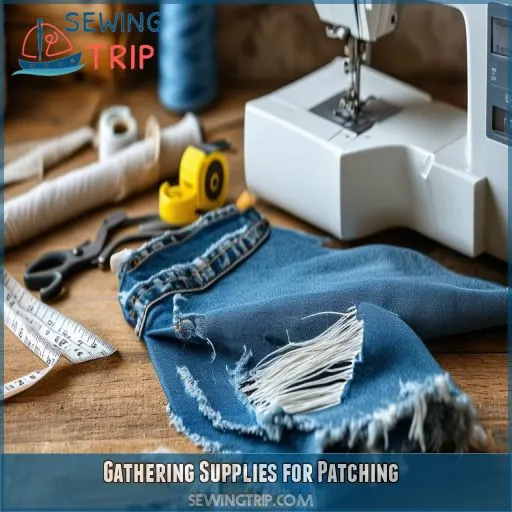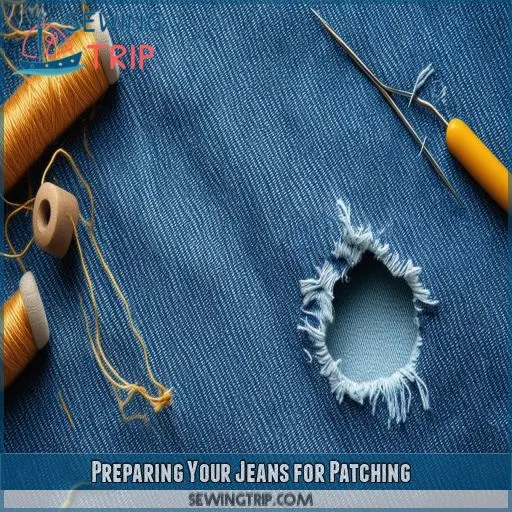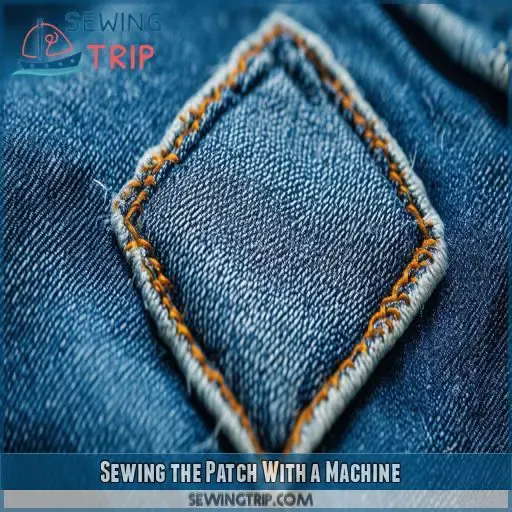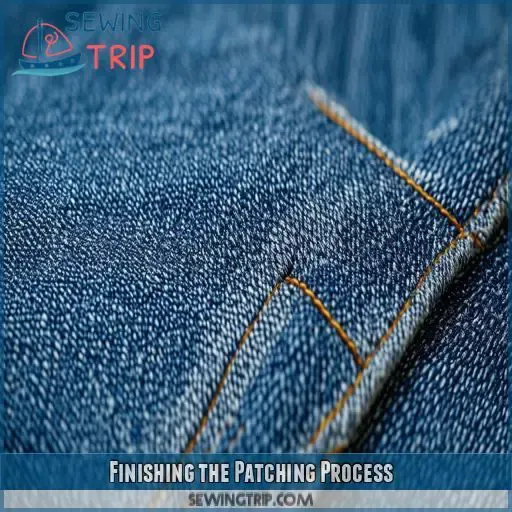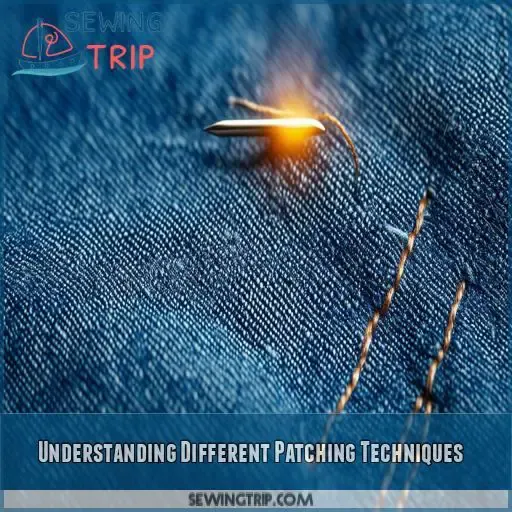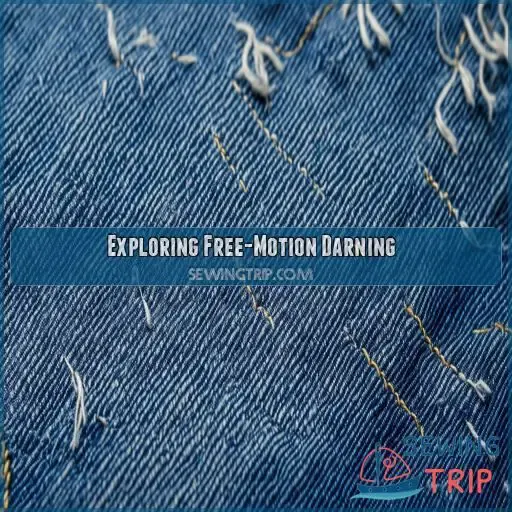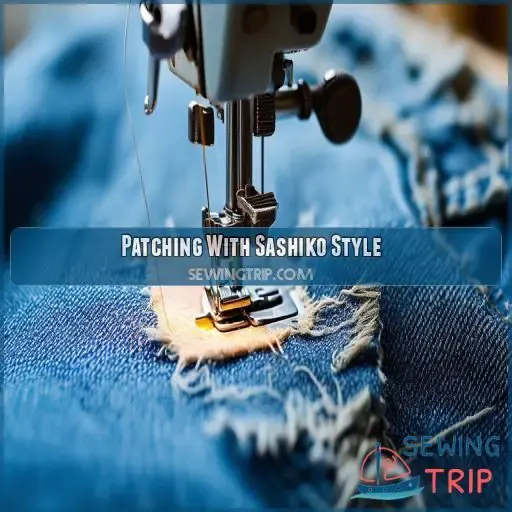This site is supported by our readers. We may earn a commission, at no cost to you, if you purchase through links.

It’s time to roll up your sleeves and learn how to sew a patch on your jeans using a sewing machine.
This step-by-step guide will teach you the tricks of the trade, ensuring your favourite pair of jeans gets a new lease on life.
From gathering supplies to finishing the patching process, you’ll be a pro in no time.
Table Of Contents
- Key Takeaways
- How to Sew Patch on Jeans With Sewing Machine Read Down Below!?
- Gathering Supplies for Patching
- Preparing Your Jeans for Patching
- Choosing the Right Stitch
- Securing the Patch in Place
- Sewing the Patch With a Machine
- Finishing the Patching Process
- Understanding Different Patching Techniques
- Exploring Free-Motion Darning
- Patching With Sashiko Style
- Tips and Tools for Successful Patching
- Frequently Asked Questions (FAQs)
- Conclusion
Key Takeaways
- Mending jeans with a patch and your sewing machine saves you cash and extends the life of your favorite denim.
- Prep is key: gather the right supplies, from patch fabric to sewing machine, and get your jeans ready for their makeover.
- Choose the right stitch for the job: straight, zigzag, whip, blanket, or running stitch—each has its superpower.
- Sewing the patch is a breeze: thread your machine, secure the thread, sew slowly, and admire your handiwork.
How to Sew Patch on Jeans With Sewing Machine Read Down Below!?
Sewing a patch on your jeans with a machine is a simple and effective way to extend their lifespan. The process is straightforward, but it’s important to gather the right supplies and prepare your jeans for patching. Choose a patch fabric that matches the colour and weight of your jeans, and select a sturdy thread in a matching shade. When you’re ready to sew, secure the thread with a few stitches at a reduced length, then carefully sew around the edges of the patch. Remember to go slow!
For more detailed instructions, as well as tips on choosing the right stitch and securing your patch, continue below.
Gathering Supplies for Patching
To sew a patch on your jeans, you’ll need to gather the right supplies. This includes picking the right materials and tools for a durable and seamless repair job.
Let’s start with the patch itself. Choose a patch fabric that matches the color and weight of your jeans. Denim or a similar sturdy fabric is ideal. Make sure the patch is large enough to cover the hole or tear completely.
Next, you’ll need a sewing machine. You’ll want to pick a machine that can handle sewing through thick denim fabric. You’ll also want to select the right needle and thread for the job. Opt for a sharp, strong needle designed for denim or universal use. As for thread, choose a high-quality, durable option that matches the color of your jeans and patch fabric.
Having the right tools and materials is key to successfully sewing a patch onto your jeans. With these supplies gathered, you’ll be well on your way to mending your favorite pair of jeans like a pro.
Preparing Your Jeans for Patching
Getting your jeans ready for patching is a key step in the repair process. It sets the stage for a successful mend, making sure your jeans are ready for a patch or stitch. Here’s how to do it:
- Lay your jeans flat on a sturdy surface, making sure there are no wrinkles or folds that could affect your repair work.
- Trim any frayed edges or loose threads around the hole using sharp scissors. This creates a clean area to work with and helps prevent further unraveling.
- Reinforce areas prone to tearing, such as the crotch seam, by sewing around them or using fabric mending tape for additional support.
- Wash and dry your jeans according to their care label instructions before beginning any repair work. Clean fabric makes sure that patches or stitches adhere properly and last longer.
Choosing the Right Stitch
When choosing a stitch, consider the garment’s wear and tear. Options include running stitch, whip stitch, blanket stitch, zigzag stitch, or backstitch.
Stitch Types
To pick the right stitch, think about how much wear and tear the garment will get. Popular stitch types include the running stitch, whip stitch, blanket stitch, zigzag stitch, and backstitch.
Thread Types
When choosing a thread for sewing patches on jeans, consider its strength, durability, and weight. Opt for a strong and durable thread in a colour that matches your jeans.
Sewing Techniques
When it comes to sewing techniques, there are a few options to choose from. You can decide between hand sewing and machine sewing, and also decide on the type of stitch that best suits your needs.
- Hand Sewing: This method offers more control and precision, especially when working with delicate fabrics or intricate designs.
- Machine Sewing: Machine sewing is faster and more efficient, making it ideal for larger projects or when time is a factor.
The type of stitch you use will depend on the specific requirements of your project:
- Running Stitch: Simple and versatile, this stitch is ideal for quick repairs or when you need to sew long distances.
- Whip Stitch: This stitch creates a strong and durable seam, making it perfect for joining two pieces of fabric together.
- Blanket Stitch: Providing a decorative finish, this stitch is commonly used for edging or finishing a raw edge.
- Zigzag Stitch: Offering stretch and flexibility, this stitch is ideal for sewing knit fabrics or creating elastic waistbands.
Securing the Patch in Place
Holding the patch in place is important for a nice, professional look.
There are a few ways to do this, each with its own advantages.
One popular method is to use temporary adhesive spray, which helps keep the patch in place before sewing.
You can also use straight pins, but be careful as they can bend or distort the patch.
For best results, put pins in from the inside of the garment to make sure the surface is flat.
Another option is to use a heat press with interfacing or fusible webbing, which creates a strong bond between the patch and the jeans.
The method you choose depends on the fabric type and what you prefer.
Sewing the Patch With a Machine
- Thread your sewing machine with a matching or contrasting thread color, depending on the style you want to achieve.
- Lower the needle into the patch and secure the thread with a few stitches at a reduced length. This will make sure your patch stays in place while you work.
- Sew slowly and carefully around the edges of the patch. You can use a straight stitch or a zigzag stitch, depending on your preference and the look you’re going for.
- Secure the thread at the end by repeating the securing process and trimming any excess threads.
- Admire your handiwork! Your jeans are now as good as new, and you’ve saved yourself the expense of buying a new pair.
Finishing the Patching Process
Now that you’ve sewn the patch, it’s time to finish the job. Go over the patch with a final pass of the iron to make sure it’s secure. Check the placement, stitch length, and security of the patch. Make sure the patch is straight and securely attached to your jeans. If you’re using an embroidered patch with a merrow edge, sew into the edge for a hidden stitch. If your patch doesn’t have a merrow edge, bury the knot by sewing around the edge.
Visible mending techniques like sashiko can add a decorative touch to your patch. Mark a 1" grid across the patch with chalk, then stitch a simple "x" design.
Understanding Different Patching Techniques
There are several patching techniques to repair your denim and each has its unique style:
- Darning: This technique involves using a darning foot for free movement and control, sewing narrow rows in different directions to create a "woven" structure over the hole.
- Patching with Sashiko: A popular Japanese style that creates an exposed patch with a simple grid of hand stitches, forming a decorative geometric pattern.
- Using Patches to Hide or Show Off: You can use matching or contrasting patches, along with different stitch types and thread thicknesses, to either conceal holes or make a bold statement.
Exploring Free-Motion Darning
Free-motion darning is a technique that uses the darning foot for free movement and stitch control. This method sews narrow rows up and down and then crosses over with side-to-side rows, creating a "woven" structure of stitches over the hole in your jeans.
Here are some key considerations for free-motion darning:
| Consideration | Description |
|---|---|
| Darning Foot | Allows free movement and control, creating a "woven" structure of stitches. |
| Stitch Control | Sew narrow rows in an up-and-down motion, then cross over with side-to-side rows. |
| Thread Tension | Use matching thread colors, often shades of gray, for a seamless repair. |
| Fabric Movement | The darning foot enables free movement, allowing you to maneuver the fabric as needed. |
Patching With Sashiko Style
Sashiko is a popular Japanese stitching style that creates decorative geometric patterns. It’s an excellent way to add a unique touch to your denim patch. Here’s how you can do it:
Mark a 1" grid across the denim patch with chalk. This will serve as your guide for stitching.
Stitch approximately 1/4" stitches in 1/2" rows. Once you’ve completed a row, move across to create an "X" design with your stitches. Continue this process until you’ve covered the desired area.
Feel free to experiment with any style of hand embroidery. You can use this technique for both embellishment and mending, adding a personal touch to your patched jeans.
Tips and Tools for Successful Patching
Now that you’ve mastered the art of patching with Sashiko style, let’s get into some tips and tools to make sure your patching projects are always a success.
- Placement Precision: Take the time to position your patch with care. Center it over the tear or hole, making sure it covers the damaged area completely. A well-placed patch strengthens the fabric but also looks neat and tidy.
- Stitch Savvy: Choose the right stitch for the job. A straight stitch is perfect for securing patches in place, while a zigzag stitch adds flexibility and can prevent further tears. Play with stitch lengths to add variety to your mending.
- Thread Talk: Opt for high-quality, durable thread that matches your fabric. Consider using multiple shorter threads instead of a long, double thread, which can be bulky and prone to looping.
- Sewing Machine: A good-quality sewing machine is your best friend for efficient and precise patching. Look for one with adjustable settings to accommodate different fabrics and stitches.
- Sewing Tools: Invest in a set of sewing tools, including scissors, needles, threaders, and pins. These tools will make your life easier and ensure a professional finish.
- Sewing Accessories: Explore sewing accessories, such as buttonhole cutters, pressing cloths, and stabilizers. These accessories can elevate your patching game and give you more control over the process.
With these tips and tools in your arsenal, you’ll be patching jeans like a pro, mending tears and transforming them into works of art.
Frequently Asked Questions (FAQs)
Can you use a sewing machine to sew patches on jeans?
Yes, you can use a sewing machine to sew patches on jeans. However, sewing by hand may be easier as it gives you more control over your stitches.
How to patch a hole in jeans with a sewing machine?
If you’re patching up a pair of jeans with a hole, you’ll want to stitch a strong, reinforced area. Sew a straight stitch across the hole multiple times, using a matching thread colour for maximum invisibility.
What is the best stitch for patching jeans?
The best stitch for patching jeans depends on the type of patch and the sewing machine being used. A straight stitch is the most common choice, but a zigzag stitch can also be used. Some sewing machines also offer darning stitches, such as Stitch #22 and Stitch #
How do you sew a patch on jeans?
Spread your jeans flat and pin the patch in place. Use a heavy-duty needle to pierce the denim and patch. Sew around the entire edge of the patch, removing pins as you go.
Whats the best way to secure a patch before sewing?
As solid as a rock, that’s how you want your patch to be before sewing. Using a tape circle or temporary adhesive spray will keep your patch from shifting. If you don’t mind a bit of heat, ironing the patch can also do the trick.
What type of needle should I use for sewing jeans?
You should use a jeans/denim needle or a universal needle for sewing jeans. Jeans needles are strong, sharp, and designed to push through heavy fabric.
Can I use a sewing machine to attach a patch?
Yes, you can use a sewing machine to attach a patch. A free-arm feature can make it easier to maneuver the fabric. Go slowly and use a zig-zag stitch, setting the width so the needle lands just outside the binding stitches.
How do I finish the patching process?
To finish, knot the thread, trim excess fabric and thread, and iron the patch. Reinforce with stitches, and tie off on the interior side of your jeans.
Whats the difference between darning and patching?
Darning uses a needle and thread to cover holes and reinforce fabric. Patching uses fabric, needle, and thread to repair holes. Darning is less visible, but patching is more durable and flexible.
Conclusion
Now you know the ins and outs of sewing a patch on your jeans with a sewing machine.
From gathering supplies to finishing the patching process, you’re equipped with the know-how to give your favourite jeans a new lease on life.

